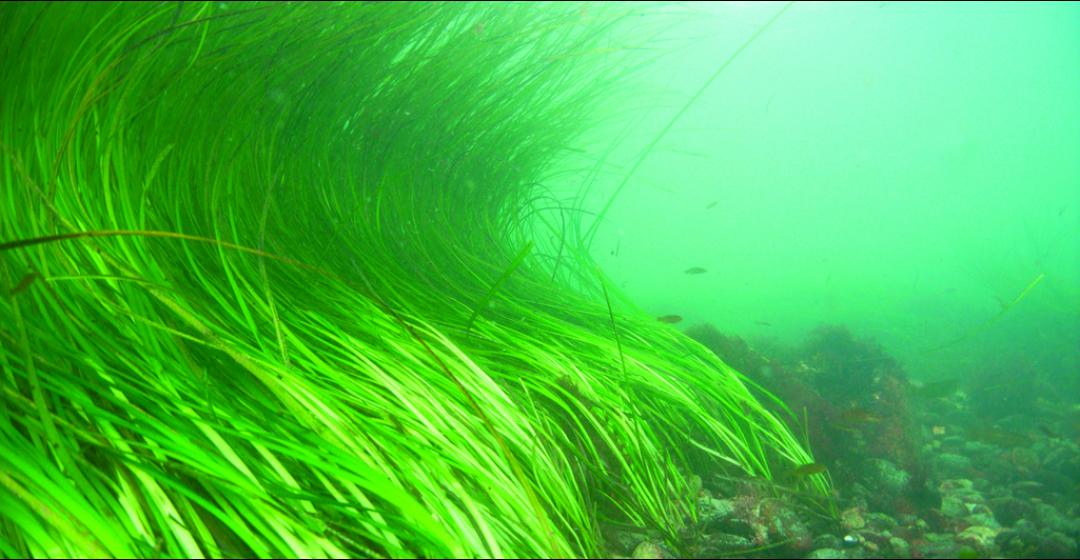It’s not uncommon these days to hear of rare or threatened plants on the Vineyard – think of the broad tinker’s weed (aka wild coffee) that recently worried the Gay Head Light movers, or the orchids that occasionally halt would-be homebuilders. But one of the most important and endangered local plants grows not so much on the Island as beside it.
Eelgrass, Zostera marina, is easy to overlook in its underwater habitat. Once, however, whole meadows of the blooming seagrass were present in coastal waters throughout Massachusetts. The plant grows in depths of up to fifteen feet – like other plants, it needs sunlight to survive – and is an important part of the coastal ecosystem, providing habitat for a number of animals, including crabs and fish. Eelgrass is especially important to bay scallops; young scallops attach to the blades of the grass, which later provide them with shelter and spawning habitat. Eelgrass root systems also stabilize the shoreline, and the blades dampen the effects of wave energy, potentially reducing erosion. A 2012 report in the journal Nature Geoscience said seagrasses could also play a role in combating climate change: seagrass meadows store twice as much carbon as temperate and tropical forests.
But the same report found that seagrasses are among the most threatened ecosystems in the world, with 29 percent of historic seagrass meadows destroyed, and 1.5 percent of the world’s seagrass meadows disappearing every year. Locally, studies by the Massachusetts Estuaries Project found significant loss of the plant in several Vineyard ponds. More than 90 percent of eelgrass in Edgartown Great Pond disappeared between 1951 and 2002, while eelgrass in Sengekontacket Pond decreased by 97 percent from 1951 to 2006. The Lagoon also has lost significant eelgrass beds. (See “Is it too Late for Lagoon Pond?” on page 64.) There is virtually no eelgrass remaining in Tisbury Great Pond.
“There’s obviously a net loss of eelgrass,” said Diane Murphy, a fisheries and aquaculture specialist at Cape Cod Cooperative Extension and Woods Hole Sea Grant. She noted that eelgrass is patchy by nature, and tends to migrate, but in the sixteen years she has worked in the area, she’s seen the decline firsthand. Some healthy eelgrass beds chosen for bay scallop restoration have degraded significantly, she said. “Those areas do not look the same today.”
Murphy has been involved in pilot studies to plant eelgrass in several areas around Cape Cod, including one early planting method that used the machines that inject jelly into jelly doughnuts, modified to deposit eelgrass seed into sediment. The studies had varying success: in one location, water quality and algae blooms hurt the plants, and in another, currents disrupted the sediment where the plantings took place. A third site, Murphy said, was affected by horseshoe crabs that uprooted the new plantings.
Various factors play a role in the plant’s decline, many of them linked to coastal development. Increased nitrogen in coastal ponds, primarily from septic systems and fertilizer runoff, leads to more algae, which depletes oxygen and blocks sunlight, both needed for eelgrass to survive. Dredging, moorings, and other marine activities associated with a denser population also displace or disturb eelgrass beds. On the Vineyard, the Tisbury Harbor Management Committee has discussed eliminating moorings on Lake Tashmoo to protect eelgrass, and a large salt marsh restoration project has been approved for Sengekontacket Pond.
Both are hopeful signs. But the bottom line, according to Murphy, will always be the long-term health of the ponds. “You could restore these things in perpetuity,” she said, “but without the habitat and the water quality integrity, you’re doomed to repeat those efforts year after year after year.”





